TORIC CONTACT LENSES
THE HIGH-QUALITY CLEAR ASTIGMATISM CONTACT LENSES
275,000₫
350,000₫
Table of contents [Hide]
Astigmatism is a refractive disorder that is often accompanied by nearsightedness or farsightedness. The cause of astigmatism is mainly due to an irregularly shaped cornea. Eyes that are both nearsightedness and astigmatism will seriously affect the ability to see in work and study activities. Currently, using this contact lenses is chosen by many young people because of its aesthetic advantages and outstanding effectiveness.
Let's learn more about astigmatism with Angel Eyes and how to choose the right contact lenses for you as well as the outstanding advantages of astigmatism and myopia lenses!
WHAT IS ASTIGMATISM?
Astigmatism is an eye disorder that occurs when the cornea of the eye is irregularly shaped and curved. In the normal eye, the image rays after passing through the cornea are focused at a point on the retina. But in astigmatism eyes, the image rays are focused at many points on the retina, causing the astigmatism to see blurry, unclear images.

People with astigmatism often see blurred vision, sometimes accompanied by distortion at all distances. There are many types of astigmatism depending on the combination of astigmatism with nearsightedness or farsightedness.

Vision of people with astigmatism
CAN ASTIGMATISM EYES WEAR THE CONTACT LENSES?
This is definitely the question of many of you: Are contact lenses for astigmatism eyes or not? Because, most of us often hear about that lens. However, now there are many types of astigmatism contact lenses correcting single astigmatism with many great advantages over glasses. Now the "astigmatism" team no longer has to worry about the problem of "Can astigmatism wear contact lenses?" because now there is a method to correct all refraction by lens with turbulence.
Currently, Angel Eyes Contact Lens also offers single turbulent lenses at -0.75 and -1.25 turbulence.
ASTIGMATISM AND NEARSIGHTED EYES CAN WEAR THE CONTACT LENSES OR NOT?

The answer is yes!! Myopia - astigmatism contact lenses can help you feel comfortable and confident without eyeglasses. For those of you with refractive errors, this lenses not only meet the aesthetic needs but also have the important use of correcting eye defects.
So, now you don't have to worry because your eyes can wear lenses! The most important thing is that you should learn carefully to choose a contact lens that is both nearsighted and astigmatism reasonable for your needs.
WHAT IS THE MYOPIA AND ASTIGMATISM CONTACT LENS?
Contact lenses for both nearsightedness and astigmatism are a type of thin colorless lens made of Silicone Hydrogel or Polyhema material, which is curved on the back to fit the cornea. Astigmatism – Myopia contact lenses will be placed directly on your pupils, helping to improve your vision in place of thick glasses that lack aesthetics.
With a simple nearsighted lens, Angel Eyes provides a number up to -15.0 myopia. With this lenses, Angel Eyes has a step of 0 to 6 with astigmatism from -0.75 to -2.25. This is a high-class myopia-astigmatism lens imported from Korea with a special design suitable for astigmatism eyes. When inserted into the eye, the lenses will automatically move to the correct axis of the wearer.
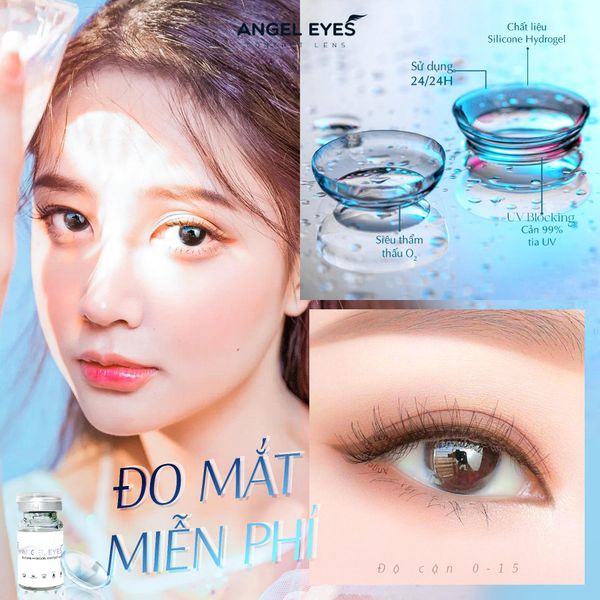
Angel Eyes' Toric myopia and astigamtism contact lens
Nano Silicone Hydrogel: This material is highly breathable, flexible and can be used for a long time up to 12-24 hours/day. The Silicone Hydrogel material itself supports gas exchange without the assistance of water crystals. Silicone Hydrogel Lenses will not need to absorb too many tears to maintain water crystals like conventional lenses. This is the most advanced contact lens technology for sensitive eyes, as well as suitable for the dry weather of Vietnam.
Anti UVA / UVB: Preventing ultraviolet rays from the sun, blue light from computers & phones. These are all factors that cause refractive errors, especially astigmatism.
Clear Vision Technology: Helps vision clearer normal lenses.
PRICE OF MYOPIA-ASTIGMATISM CONTACT LENSES
Today, the contact lens market is very diverse. The price of high-end for this model usually ranges from 600,000 - 800,000 VND.
At Angel Eyes, the price of this contact lenses is 550,000 VND - the best price on the market today for a high-end product with Silicone Hydrogel material from Korea. In addition, you will be given a mirror tray with support tools worth 35,000 VND.

The myopia - astigmatism contact lens of Angel Eyes
HOW TO CHOOSE THIS LENS FOR MYOPIA-ASTIGMATISM EYES?
To choose the right myopic wear for your individual eyes condition, before buying lens, you should measure your eyes to get the latest and most accurate results.
Coming to Angel Eyes, you will receive a completely free eye exam with dedicated and enthusiastic specialists along with modern equipment. You can have peace of mind to choose the most suitable myopic for contact lenses at Angel Eyes.
Eye exam & contact lens consultation process at Angel Eyes:
B1: Inquire about the customer's need for contact lenses
B2: Specialized eye drops to make eyes more balanced and comfortable before measuring eyes
B3: Eye measurement with modern Japanese optometry machine

B4: Compare with the customer's current glasses. Current opacity is checked with a super-precise lens meter
B5: Perform clinical examination with test glasses and optometry light board

B6: Consult the appropriate myopic lens and model for customers

The formula should be for reference only.
Actual astigmatism contact lens wear is accurate only through eye examination and testing with glasses.
B7: Instructions for wearing contact lenses in place as well as how to wear lenses, how to remove lenses, how to take care of lenses
B8: Save customer information for warranty & after-sales work
Currently, myopia-astigmatism contact lenses are sold a lot with diverse designs and origins. You should not buy and use by yourself without testing and guidance of experts. Because this will cause a lot of bad effects on eyesight.
HOW TO READ THE VISION RESULTS?
If it is your first time measuring your eyes, you will probably be confused and do not understand the measurement parameters displayed on the result sheet. Therefore, reading and understanding the results of eye measurements is the knowledge that you should equip.
The most common ways to read the results of the refractive test are: reading for eyes with nearsightedness, astigmatism, and farsightedness. Or have eyes with both cases. These measurements will definitely be the same for the left eye and the right eye. Therefore, you must distinguish the symbols so as not to confuse the measurement results in both eyes. Specifically, the correct way to read and understand the standard eye measurement results is specified as follows:

Simple result form made by customer's eyes at Angel Eyes Contact Lens
First, if your eyes are nearsighted, your eye measurement results will have the symbol "-". If you are farsighted, replace it with a "+" sign. The "-" and "+" sign mean for convex and concave lenses that you will be cut and put on afterwards to see well. At any ophthalmology facility, the measuring staff or the doctor will record the parameters for the right eye first. Right and left eyes have common conventions for identification. Detail:
- Eye measurement results must be written after the letter "Right" or after the symbol "O.D" or the symbol "R".
- Measurement results for the left eye are written after the letter "Left" or after the symbol "O.S" or the symbol "L".
- Demand (SPH): myopic Near minus sign (-); Far myopic plus sign (+).
- Cylinder (CYL): myopic of Sub-minus astigmatism (-).
- Axis (AXIS): the axis of the astigmatism. This indicator is available for astigmatism.
- Plus (ADD): near vision (equivalent to distance vision plus). This indicator is available for presbyopia.
- PD (pupil distance): this index is also very important when cutting glasses. When there is concentricity between the pupil and the center of the cut lens, it will give the clearest vision. Being off-center will cause image distortion and inconsistency.
- VD is the distance from the lens to the pupil. For contact lenses, this distance will be 0.
- SE (Recommended Glass) The new generation of optometrists will support this parameter through computational AI. This recommended parameter will convert myopia (Or far), the disorder of the eye to give a near (or far) parameter that the machine thinks will be most suitable for the eye. However, the refractive technician will always have to double check this with a test glass.
Normally, the meter will measure each eye 3 times (3 lines of top) and give a result that the meter calculates to be the most accurate in the 4th row marked with a < >
For example: As shown in the illustration above, the customer's nearsightedness is:
Right eye: Nearsightedness 3.25 - Astigmatism 1.00 and Axis number is 1
Left eye: Nearsightedness 2.50 - Astigmatism 1.75 and axis number is 5
The pupil distance is: 61mm
The distance from the lens to the pupil is 12mm
HOW TO READ THE PARAMETERS OF CONTACT LENSES?
In addition to choosing for yourself a contact lens model that is suitable for your needs, you should also pay attention to the contact lens box, there will certainly be some strange characters and symbols, and if you do not understand that information, it will be difficult for you to choose a product that is suitable for your eyes. Reading the product parameters will help you choose the best myopia contact lenses for your eyes.

All parameters are displayed on the packing of contact lens
The first and most important information is the color of the product. This information is shown on the top right edge of the box. The color name is printed on the color background to help customers easily visualize and the box design is also more diverse and eye-catching. No need to open the box, customers can also check the color of the product at this position of the box to avoid being mistakenly delivered by the supplier.
Below that is the information "0.00" or "-2.00" representing the nearsightedness of the lens. This is an important parameter for customers who need to use contact lenses to correct refractive errors. "0.00" indicates myopia-free contact lenses. "-2.00" indicates contact lenses for customers with 2 myopic (this number varies depending on the myopia of the inner lens. With Angel Eyes contact lenses, this number will range from - 0.5 to -15.00).
Other parameters include:
⭕ Name: Diop
Symbol: PWR, D, SPH, dpt, Refr or F'
Meaning: The degree of contact lens is measured in Diop (value from -20.00 to 20.00)
⭕ Name: Basic curve
Symbols: BC, Radius oder
Meaning: The arc of the contact lens (value from 8.0 to 10.0)
⭕ Name: Diameter
Symbol: DIA or øT
Meaning: Diameter of contact lens (value from 13.0 - 15.0)\
Note to customers with myopia when using contact lenses: Wearing contact lenses with the wrong degree of myopia will cause eye strain or eye pain, so you need to go to an ophthalmology clinic first to measure. nearness again. For those of you with myopia above 3 degrees, you should choose contact lenses that reduce the degree from 0.25 - 0.5 for better vision.
Check the back side: The first index is "BC 8.6". BC stands for base curve, which represents the curve of the inner lens. With Vietnamese eye characteristics, the best BC ranges from 8.6 to 8.9. With this curvature, the glasses will fit snugly on the iris and can move flexibly according to the movement of the iris for a more natural look, and at the same time allow oxygen to enter the lacrimal gland to provide oxygen for the eye's activities.
WHAT IS DIA OF THE CONTACT LENSES?
👁️ DIA (diameter): is the diameter of the entire lens, including the transparent border surrounding the outside. The DIA diameter is usually between 13.0 and 15.0 mm.
-
Contact lenses are usually 14.0 - 14.2mm in diameter.
-
The diameter of dilated lenses will be larger from 14.2 - 20mm.
For Vietnamese eyes, contact lenses with DIA 14.2 - 14.3mm are just enough to bring the feeling of natural big and round eyes. DIA from 14.5 to 15mm or more is for those with big eyes or those with makeup who want to have bigger eyes than normal.
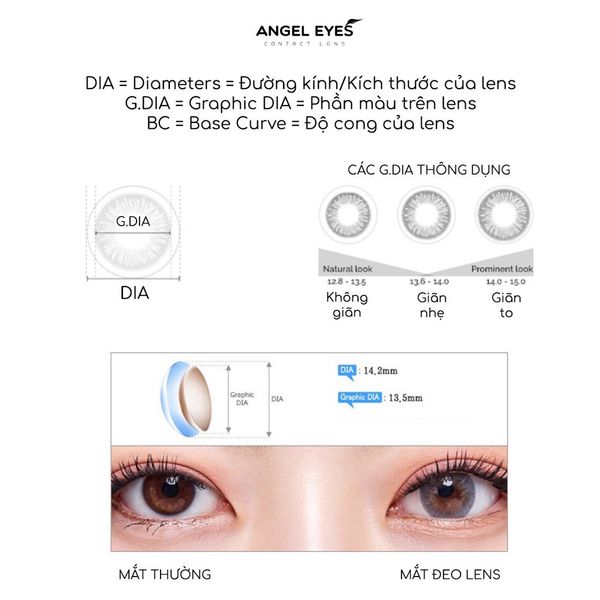
Symbol "DIA 14.0": This symbol represents the diameter of the lens in mm. For example, DIA 14.0 means the diameter of the inner lens is 14mm. Same with 14.2 dilated lenses, 14.5 dilated lenses or 15mm dilated lenses. However, Vietnamese eyes are small to medium, so it is advisable to choose lenses with a lens elongation ranging from 14 to 14.5 for natural and comfortable eyes while ensuring the golden ratio. of the eye: 1-2-1 (1 white - 2 black - 1 white).

Golden Ratio "1-2-1" to choose the contact lens
WHAT IS GRAPHIC DIA OF THE CONTACT LENSES?
👁️ Graphic DIA (abbreviated as Gdia): is the diameter of the iris in the middle of the lens. The Graphic DIA parameter is usually a little smaller than the DIA, for example 13.5mm, 13.7mm… The irises of our eyes are about 12.8mm to 13.0mm in diameter, the closer the Graphic DIA to these two numbers, the better the eye will look. natural, not too big. Please note, lenses have the same DIA index but different Graphic DIA when worn on the eyes will look different. The Graphic DIA is the most important indicator for choosing an iris, so you should ask before buying.
Note: Clear contact lens will not have GDia.

How to distinguish Dia and GDia
HOW TO WEAR THE CONTACT LENESE?
-
Wash your hands before wearing contact lenses
-
Open the tray and pour the new contact lens solution into the tray
-
Open the lens holder and take the contact lenses into the tray. The first time you use it, you should soak it for 4-6 hours before wearing it to remove any remaining preservatives
-
Eye drops to disinfect and remove dust before and after wearing lenses
-
Before wearing, gently shake the lens to prevent water from forming, place the lens on the tip of the index finger so that the rim does not stick to the hand.
-
Identify the correct lens face before wearing.
-
Pull the eyelids with two middle fingers, bring the lens to the eyes, raise the eyes upwards. Do not roll your eyes, focus on one point. Put the lens on the eye, the lens will hug itself to the pupil.
-


Intructions for wearing lens with pictures
Notes:
- Should wear contact lenses before makeup, if the powder accidentally falls into the eyes, gently pick up the cotton swab and remove the dust, and at the same time drop the eyes, avoid making small water run out, it will wash away the makeup.
- Before putting contact lenses in your eyes, you should drop eye drops, or put 1 drop into the lens to keep it moist, making it easier for the lens to stick to your eyes. Do not skip the step of eye drops for lenses, because eye drops when wearing lenses can help clean your eyes if accidentally dust gets in. At the same time, eye drops for lens wearers also help balance moisture for both eyes and lenses.
- If you do not have a contact lens device, you need to wash your hands thoroughly and do not let your fingernails come into contact with the lens, use only the flesh of your finger to wear the lens (to avoid scratching the cornea or tearing the lens).
HOW TO REMOVE THE CONTACT LENSES?
Before removing contact lenses, you should add 1-2 drops in each eye to re-moisturize the cornea & contact lenses.
If you do not have a lens removal tool, you need to wash your hands thoroughly and do not let your nails come into contact with the lens, only use the flesh of your finger to remove the lens (to avoid scratching the cornea or tearing the lens).
After removing contact lenses, add 1-2 drops on each side to re-hydrate eyes. At this time, other eye drops can be instilled.
Contact lenses, when removed from the eye, should be immediately placed in a lens tray containing fresh soaking solution. You should make it a habit to put your contact lenses in the correct L or R tray for each left or right eye. This is especially important for those who wear contact lenses with the deviation between the eyes.
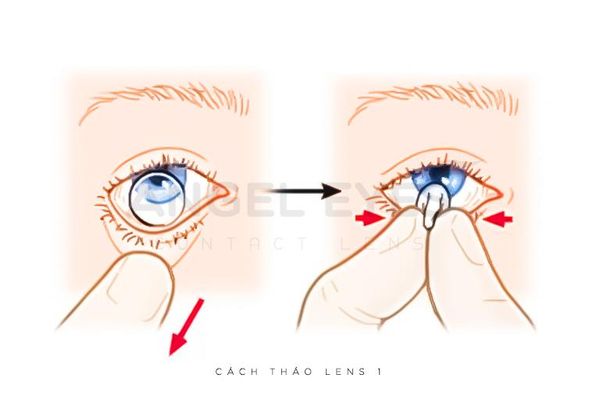

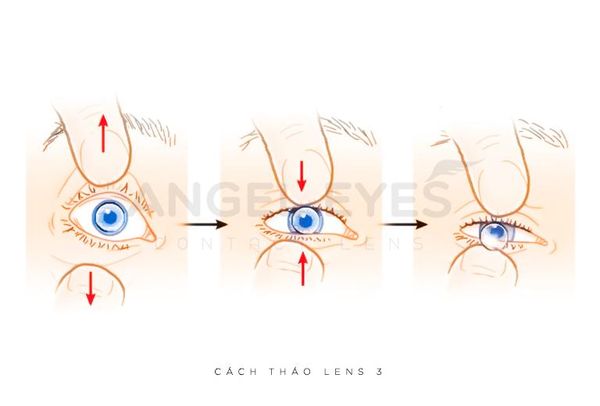
Intructions for removing lens with pictures
HOW TO TAKE CARE OF THE CONTACT LENS?

If myopia is skewed, notice on the lens tray cover the letters L (Left), and R (RRight). Just put the contact lens on the right side.
- When removing contact lenses from the vial/blister, the lenses should be soaked for at least 4 hours in the soaking solution to remove the preservative in the water from the contact lens vial/blister.
- If you feel your eyes are dirty like dust, you should immediately change the soaking water and remove the lens and wash it thoroughly. You can wash contact lenses with a lens washer. However, in the case don’t have lens washer, you can wash your hands, put some soaking solution and contact lens in the palm of your hand and use your other finger to gently dust off the lens.
- Absolutely don’t wash the eye lens with soap, the lens will not be used anymore.
- After each time you wear contact lenses, you should change the soaking water, always keep the soaking water clean & clear, because if there is dirt and dust, the lens will be very easily scratched. In case you do not use contact lenses every day, you also need to pay attention to change the soaking water every other day to ensure hygiene.
IS YOUR CONTACT LENS INSIDE OUT?

The picture depicts the right and wrong lens surface
The trick is to place the lens on your finger so that a cup is formed. Then hold the lens up directly in front of your eyes so you're looking at the side of the cup.
If the edges of the lens flare out to create a “lip” along the edges, it's inside out. If it forms just a perfect "U" shape, it's in the correct position.
Some contact lenses also have a laser marking, such as the brand name, on the edge to help you. If you can read it properly, the lens is not inside out.
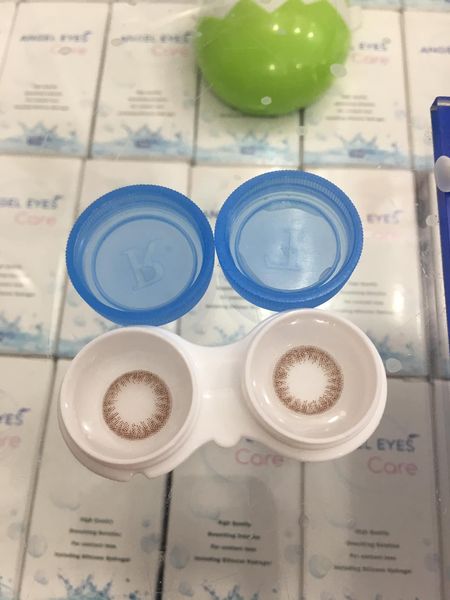
The outside of the lens will be darker than the inner side that is pressed against the pupil
NOTE WHEN USING THIS LENS
❣️ Please carefully refer to the information on the instructions for use, how to wear contact lenses safely, how to store and especially the time of use of the product you choose.
❣️ When you first start using you do not wear contact lenses for too long: For newbies, the first day you should only wear it up to 3 - 4 hours, Monday 4 - 5 am, Tuesday 5 - 6 am, from Wednesday 6 - 8 am. Later, when you get used to it, you should only wear contact lenses for that period of time to keep your eyes healthy.
❣️ If you are short-sighted, pay attention to the letter L (Left) and R (Right) on the lens tray cover. Just put the lens on the right side
❣️ Absolutely do not use expired contact lenses, contact lenses are manufactured in many different product lines and each line will have a specific expiration date, some products are only used once and most of the time. Users choose products that can be used many times with a term of 1 month, 3 months or even a year.
❣️ Should be lowered to 0.25 - 0.5 degrees compared to wearing glasses to avoid being shocked when wearing lenses. But you need to clearly provide nearsightedness (and disorder, if any) for more detailed advice!
❣️ Stop wearing contact lenses immediately after experiencing symptoms such as red eyes, blurred vision, or discomfort and consult an ophthalmologist immediately.
❣️ Do not use tap water or filtered water to clean, soak and preserve contact lenses. Store in contact lens solution only.
❣️ Do not share contact lenses with anyone to ensure eye hygiene and safety.
❣️ Do not wear contact lenses when sleeping, do not wear contact lenses when swimming because the water contains many bacteria. Wearing contact lenses while swimming increases the risk of eye infections and gangrene.
❣️ Do not wear contact lenses when eye pain: Direct contact with the pupil, contact lenses can aggravate your eye pain.
❣️ Put on contact lenses before applying makeup to prevent eyeshadow or other makeup products from sticking to contact lenses.
❣️ For people with small eyes, you should not choose dilated lenses. You should buy lenses with a small DIA to make them easier to carry.
PRESTIGE CONTACT LENS ADDRESS FOR SALE
One of the most popular places to buy nearsighted lenses today is Angel Eyes Contact Lens. Angel Eyes products are imported directly from Korea, have the safety certificate of the Ministry of Health of Vietnam, are favored by millions of customers during 7 years of operation.
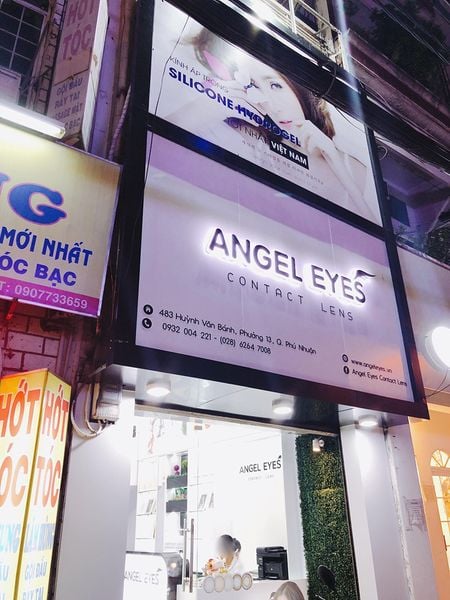
ANGEL EYES' Stote at 501 Huynh Van Banh, Ward 13, Phu Nhuan District, HCMC

The Licence of Ministry Of Health Vietnam for all products at Angel Eyes Contact Lens
Here, in addition to all lens/contact lens models available with myopia, you can also be consulted by Angel Eyes' friendly and dedicated staff on models that suit your own style. In addition, Angel Eyes also supports contact lens wearing instructions for those who are new to wearing them for the first time, only from 10-30 minutes, you can wear lenses proficiently.
In addition, Angel Eyes also offers door-to-door delivery (within the day) nationwide when you need to buy lenses in central districts, including Go Vap, Binh Tan, Hoc Mon, Binh Chanh, ...
With a nationwide branch network, Angel Eyes is ready to serve and help your eyes become brighter and more beautiful.

ANGEL EYES' STORE
For all customers who use contact lens products at Angel Eyes, the company supports 1 to 1 warranty support for defective products from the manufacturer in the first 2 weeks. During the use process, Angel Eyes always monitors and enthusiastically cares for and guides customers. With these benefits, Angel Eyes is a reputable lens store that you cannot ignore!
Let's save the information of Angel Eyes:
501 Huynh Van Banh, Ward 13, Phu Nhuan District, HCMC
Opening hours: 8:30am - 9:00pm (Monday - Saturday) | 8:30am - 8:00pm (Sunday)
Hotline: 0932 004 221
Phone: 028 6264 7008
Website: www.angeleyes.vn
Fanpage: Angel Eyes Contact Lens
Instagram: @angeleyes.vn




